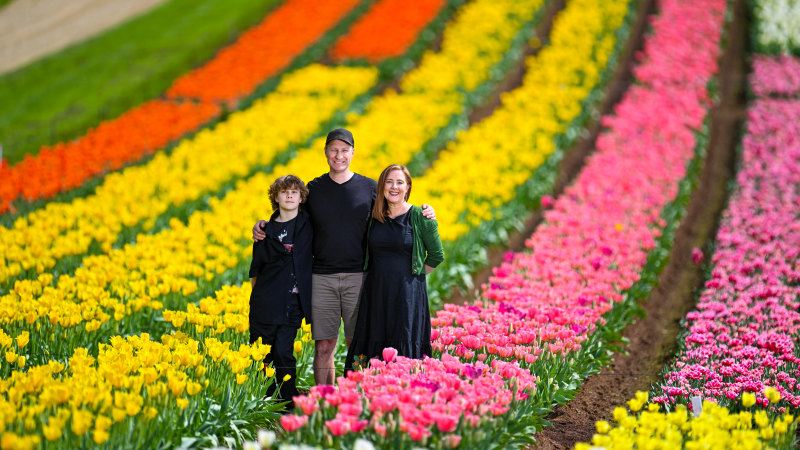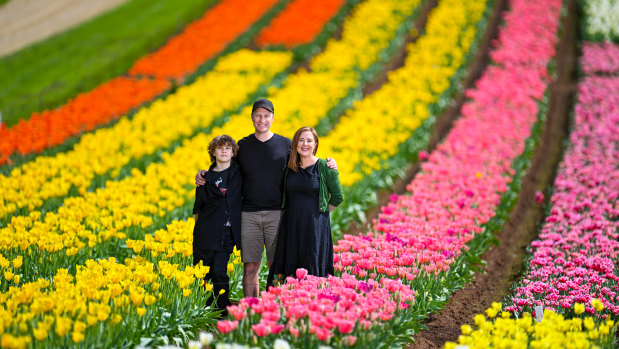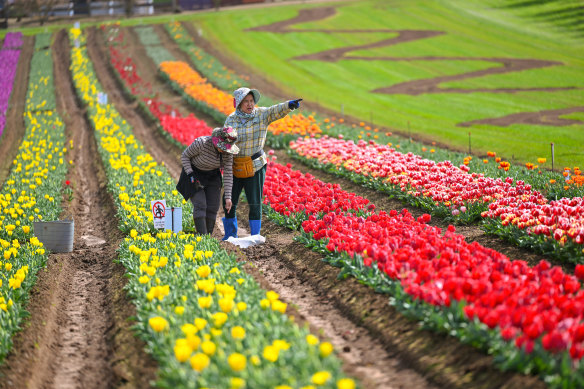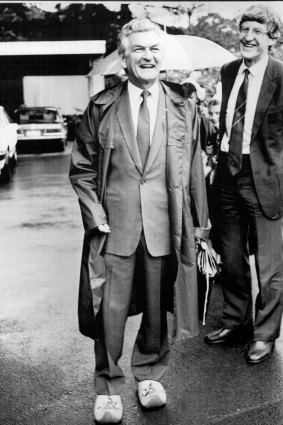Save articles for later
Add articles to your saved list and come back to them any time.
As a child, Paul Tesselaar remembers getting paid a couple of dollars a day each spring to put on clogs and pose for photos with tourists at his family’s tulip farm.
“I loved it and I think most of my cousins did as well, it was an annual thing where we all got together and we would anticipate the roster coming out,” says the 46-year-old third-generation tulip farmer.
Tulip farmers Paul Tesselaar and wife Rachael on the farm with their son Austin.Credit: Joe Armao
These days, the Tesselaar Tulip Festival in Silvan is a big event, with hundreds of thousands of people expected to attend the month-long celebration of around 850,000 bulbs blooming in yellow, pink, white and red.
The origins of the festival date back to 1954, when Paul’s grandparents, Cees and Johanna Tesselaar, first opened their farm to the public after people kept jumping the fence to admire the fields of colourful flowers.
Cees and Johanna had migrated from Holland to Australia before the outbreak of WWII, catching one of the last ships to leave Europe on their wedding day.
With an interest in the tulips, they wanted to find a place with good conditions to grow the Dutch floral icon and chose to settle in Melbourne after reading that bulbs were exported there.
There are 850,000 bulbs on show at the Tesselaar Tulip Festival.Credit: Joe Armao
Silvan, on the eastern side of Mount Dandenong, appealed because of its cooler climate and higher rainfall than areas closer to Melbourne. The rich, volcanic topsoil provided the final ingredients and the family business was born.
After the war, European migration to Australia skyrocketed. Those who landed in Melbourne speaking Dutch were pointed towards the tulips growing east of Melbourne, which created a community around towns like Monbulk that still carries the last names of those who came from the Netherlands.
“The stories go that my grandparents would receive new immigrants at all hours of the night to the point where there’d be knocks at the door at 10 o’clock at night and there’d be a small family on the doorstep looking for a place to stay,” said Paul.
Former prime minister Bob Hawke wears clogs during a visit to the Tesselaar tulip farm in 1986.Credit: The Age
“My grandmother and grandfather were very hospitable and set them up for the night and the next day they’d set about either finding work on our own farm or finding work with other farmers around the area.”
The Tesselaar tulip business split among the family a generation ago, with Paul eventually taking over the online ordering business and the annual festival.
In the past, only part of the fields would be seen by the public and the rest of the tulips were for production. These days, all of the flowers grown are on show. A second festival, Kabloom, runs during autumn.
“We bookend winter with both festivals,” said Paul.
“The Tulip Festival is this celebration of spring, Melbourne has just gone through the gloomy wet period of winter that we have. And then you notice it in the morning, it’s getting lighter and you hear the birds chirping. And the foliage on the trees is starting to emerge.
“You get this beautiful sense that spring is on its way and then the tulips start emerging as well, and you’ve got these fields full of beautiful brightly lit colours.”
This year’s Tulip Festival showcases over 120 cultivars of tulips, from traditional favourites to rare and exotic varieties. Visitors can explore the gardens and fields, with live music, food stalls, and range of children’s activities on site.
Paul said that the warmer than expected start to spring this week would mean the tulips were already looking beautiful. “My tip is to get out and see them sooner rather than later,” he said.
The Tesselaar Tulip Festival runs from September 16 to October 15.
Get the best of Good Weekend delivered to your inbox every Saturday morning. Sign up for our newsletter.
Most Viewed in National
From our partners
Source: Read Full Article



